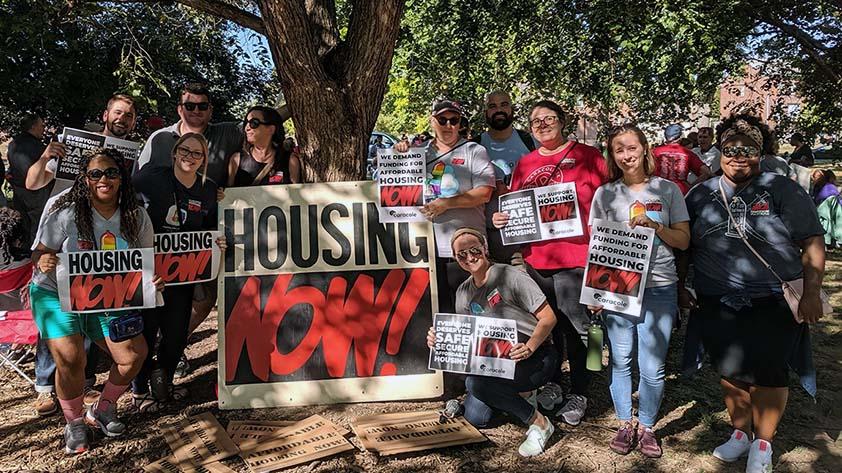Caracole, an AIDS Service Organization, uses three interconnected approaches to improve retention in HIV care: housing first, harm reduction, and motivational interviewing. Clients in permanent supportive housing had high rates of viral suppression, exceeding Caracole's goal of 75%.
Cincinnati, OH
Homelessness and housing instability are major threats to HIV management. A safe, affordable home is a necessary platform for rest, nutrition, medical engagement, and medication adherence. Caracole’s approach connects individuals to housing and addresses barriers they may face in maintaining housing.
Caracole provides permanent supportive housing services to individuals with the greatest needs, taking into consideration the individual's mental health, substance use, chronic co-occurring conditions, legal history, length of time experiencing housing instability, and viral load. Caracole works with the region’s Coordinated Entry System to identify individuals who are of greatest need and eligible for Caracole housing programs which are funded by the U.S. Department of Housing and Urban Development (HUD).
Caracole housing specialists then identify a housing unit that accepts the subsidy. This process can be challenging given the:
- Limited supply of apartments considered “rent reasonable” (HUD’s criteria for how much total rent can be charged for a unit) and
- Number of landlords willing to accept the subsidy.
To encourage uptake of the subsidy, Caracole educates landlords about the support it provides clients to make the housing placement successful and its willingness to step in to resolve disputes or mitigate issues. Over the years, Caracole has developed a list of landlords who are willing to rent to their clients based on good experiences and mutual trust.
Caracole offers tips and supports to help clients stay in their homes. For example, Caracole leverages private funds to fill gaps when clients are unable to pay their rent (approximately 30% of their income) or other necessities due to extenuating circumstances. Housing specialists may suggest other strategies to improve placement success, such as installing punch code door locks if clients tend to lose their keys. One housing specialist hosts a monthly tenant meeting to encourage behaviors that keep people housed.
Caracole’s integrated team of housing specialists and medical case managers must build trust with clients to help mitigate issues that might jeopardize long-term housing stability. This relationship often starts with home visits. If staff see concerning behaviors that could lead to eviction, they are careful not to judge. Instead, they explore with the client what is triggering the behaviors and potential mitigation strategies through motivational interviewing. Through this technique, staff “build a map” with clients to help them reach their long-term goals, starting with their most immediate concerns.
Harm reduction services are also a key component of the housing first intervention because they bring Caracole into contact with individuals who may be in need of housing services. In addition, through these services, Caracole builds trust with individuals and connects them to other support services and medical care. Finally, harm reduction services help improve housing stability, especially if clients choose to reduce substance use through medication assisted treatment, offered through one of Caracole’s referral partners.
|
Category |
Information |
|---|---|
|
Evaluation data |
Caracole calculates key measures for its entire client population and those participating in housing programs every quarter. |
|
Measures |
|
|
Results |
In 2020:
|
Source: Permanent Supportive Housing & Viral Load Suppression slide deck. 2020.
“We're pretty tireless advocates for our clients. We've developed relationships with outside partners and groups, such as Legal Aid. So, when our clients do run into trouble we also help them fight for their apartments, and to keep themselves housed. And, we work with our clients to make sure that they're being good tenants as well.”
Funding streams. Caracole leverages federal rent subsidy programs as well as other government and private grants to provide client-centered housing and supportive services.
Housing specialist staff. Five full-time housing specialists support 175 households in scattered-site permanent supportive housing in the community. An additional team supports Caracole’s site-based housing program, which houses an additional 19 people and provides 24/7 onsite support.
Housing needs assessment. Caracole and the Coordinated Entry System use the federal Vulnerability Index - Service Prioritization Decision Assistance Tool (VI-SDAT) to identify the clients in greatest need of permanent supportive housing.
Motivational interviewing. Caracole became familiar with motivational interviewing through a local physician who used the technique with families of obese children. Caracole then adopted the practice with the support of expert consultants and an innovations grant from the Ohio Department of Health.
Case manager supervision. Case managers participate in monthly group supervision, during which they discuss different client situations and share advice on how to talk to and motivate their clients.
- Caracole’s program relies on steady HUD funding for housing subsidies. In addition, the Ohio Department of Health Ryan White HIV/AIDS Program (RWHAP) Part B recipient recently awarded Caracole additional funds to support two housing specialists.

Caracole Team
- Motivational interviewing has been an effective strategy with Caracole’s high-needs clients. Through a series of open-ended questions, staff express empathy with client challenges and help clients to identify what they want to accomplish in a set period of time.
- Bus passes, gift cards to local food establishments, protein bars, and hygiene supplies go a long way in meeting clients’ basic needs. They also encourage clients to engage in the services offered through Caracole. In addition, people receive a $60 gift card when they become virally suppressed and graduate from the Viral Load Suppression for HIV Program. Caracole uses a combination of RWHAP dollars and state and private grants to fund these client incentives.
- Caracole has maintained strong relationships with partner agencies that provide housing, mental healthcare, and other social supports throughout the area by being generous with time and resources. Staff participate in workgroups and collaboratives and share policies and procedures with partner organizations. Caracole also established liaisons to lead communications with each area infectious disease provider to ensure responsiveness. As a result, Caracole enjoys an ample network of service partners for client referrals.
- Flexible funding streams promote housing access to ensure that every need to the extent possible, from HUD-subsidized rent to application fees and cleaning supplies, is met for clients in need.

